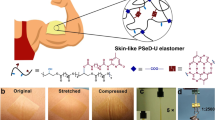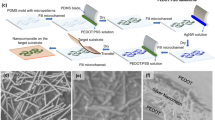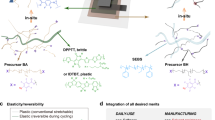Abstract
Realizing the full potential of stretchable bioelectronics in wearables, biomedical implants and soft robotics necessitates conductive elastic composites that are intrinsically soft, highly conductive and strain resilient. However, existing composites usually compromise electrical durability and performance due to disrupted conductive paths under strain and rely heavily on a high content of conductive filler. Here we present an in situ phase-separation method that facilitates microscale silver nanowire assembly and creates self-organized percolation networks on pore surfaces. The resultant nanocomposites are highly conductive, strain insensitive and fatigue tolerant, while minimizing filler usage. Their resilience is rooted in multiscale porous polymer matrices that dissipate stress and rigid conductive fillers adapting to strain-induced geometry changes. Notably, the presence of porous microstructures reduces the percolation threshold (Vc = 0.00062) by 48-fold and suppresses electrical degradation even under strains exceeding 600%. Theoretical calculations yield results that are quantitatively consistent with experimental findings. By pairing these nanocomposites with near-field communication technologies, we have demonstrated stretchable wireless power and data transmission solutions that are ideal for both skin-interfaced and implanted bioelectronics. The systems enable battery-free wireless powering and sensing of a range of sweat biomarkers—with less than 10% performance variation even at 50% strain. Ultimately, our strategy offers expansive material options for diverse applications.
This is a preview of subscription content, access via your institution
Access options
Access Nature and 54 other Nature Portfolio journals
Get Nature+, our best-value online-access subscription
$29.99 / 30 days
cancel any time
Subscribe to this journal
Receive 12 print issues and online access
$259.00 per year
only $21.58 per issue
Buy this article
- Purchase on Springer Link
- Instant access to full article PDF
Prices may be subject to local taxes which are calculated during checkout





Similar content being viewed by others
Data availability
The main data supporting the results in this study are available within the paper and its Supplementary Information. Source data for Figs. 1–5 are provided with this paper. Source data are provided with this paper.
References
Jung, D. et al. Highly conductive and elastic nanomembrane for skin electronics. Science 373, 1022–1026 (2021).
Choi, S. et al. Highly conductive, stretchable and biocompatible Ag–Au core–sheath nanowire composite for wearable and implantable bioelectronics. Nat. Nanotechnol. 13, 1048–1056 (2018).
Lee, W. et al. Universal assembly of liquid metal particles in polymers enables elastic printed circuit board. Science 378, 637–641 (2022).
Matsuhisa, N. et al. Printable elastic conductors by in situ formation of silver nanoparticles from silver flakes. Nat. Mater. 16, 834–840 (2017).
Veerapandian, S. et al. Hydrogen-doped viscoplastic liquid metal microparticles for stretchable printed metal lines. Nat. Mater. 20, 533–540 (2021).
Hui, Y. et al. Three-dimensional printing of soft hydrogel electronics. Nat. Electron. 5, 893–903 (2022).
Jiang, Z. et al. A 1.3-micrometre-thick elastic conductor for seamless on-skin and implantable sensors. Nat. Electron. 5, 784–793 (2022).
Zhao, Y. et al. A self-healing electrically conductive organogel composite. Nat. Electron. 6, 206–215 (2023).
Jiang, Z. et al. Highly stretchable metallic nanowire networks reinforced by the underlying randomly distributed elastic polymer nanofibers via interfacial adhesion improvement. Adv. Mater. 31, 1903446 (2019).
Luo, Y. et al. Technology roadmap for flexible sensors. ACS Nano 17, 5211–5295 (2023).
Wang, C., He, T., Zhou, H., Zhang, Z. & Lee, C. Artificial intelligence enhanced sensors—enabling technologies to next-generation healthcare and biomedical platform. Bioelectron. Med. 9, 17 (2023).
Choi, S., Han, S. I., Kim, D., Hyeon, T. & Kim, D.-H. High-performance stretchable conductive nanocomposites: materials, processes, and device applications. Chem. Soc. Rev. 48, 1566–1595 (2019).
Sim, K., Rao, Z., Ershad, F. & Yu, C. Rubbery electronics fully made of stretchable elastomeric electronic materials. Adv. Mater. 32, 1902417 (2020).
Gao, W. et al. Fully integrated wearable sensor arrays for multiplexed in situ perspiration analysis. Nature 529, 509–514 (2016).
Yang, Y. & Gao, W. Wearable and flexible electronics for continuous molecular monitoring. Chem. Soc. Rev. 48, 1465–1491 (2019).
Kim, J. J. et al. Skin electronics: next‐generation device platform for virtual and augmented reality. Adv. Funct. Mater. 31, 2009602 (2021).
Yamagishi, K., Zhou, W., Ching, T., Huang, S. Y. & Hashimoto, M. Ultra‐deformable and tissue‐adhesive liquid metal antennas with high wireless powering efficiency. Adv. Mater. 33, 2008062 (2021).
Zhuang, Q. et al. Wafer-patterned, permeable, and stretchable liquid metal microelectrodes for implantable bioelectronics with chronic biocompatibility. Sci. Adv. 9, eadg8602 (2023).
Jung, D. et al. Adaptive self‐organization of nanomaterials enables strain‐insensitive resistance of stretchable metallic nanocomposites. Adv. Mater. 34, 2200980 (2022).
Wang, T., Liu, Q., Liu, H., Xu, B. & Xu, H. Printable and highly stretchable viscoelastic conductors with kinematically reconstructed conductive pathways. Adv. Mater. 34, 2202418 (2022).
Kim, S. H. et al. An ultrastretchable and self-healable nanocomposite conductor enabled by autonomously percolative electrical pathways. ACS Nano 13, 6531–6539 (2019).
Sun, B. et al. Gas‐permeable, multifunctional on‐skin electronics based on laser‐induced porous graphene and sugar‐templated elastomer sponges. Adv. Mater. 30, 1804327 (2018).
Yi, H. et al. Constructing high-performance 3D porous self-standing electrodes with various morphologies and shapes by a flexible phase separation-derived method. J. Mater. Chem. A 7, 22550–22558 (2019).
Wang, Y., Yokota, T. & Someya, T. Electrospun nanofiber-based soft electronics. NPG Asia Mater. 13, 22 (2021).
Zhu, D., Handschuh-Wang, S. & Zhou, X. Recent progress in fabrication and application of polydimethylsiloxane sponges. J. Mater. Chem. A 5, 16467–16497 (2017).
Yao, S. et al. Ultrasoft porous 3D conductive dry electrodes for electrophysiological sensing and myoelectric control. Adv. Mater. Technol. 7, 2101637 (2022).
Zhou, W. et al. Gas-permeable, ultrathin, stretchable epidermal electronics with porous electrodes. ACS Nano 14, 5798–5805 (2020).
Wang, F. et al. Progress report on phase separation in polymer solutions. Adv. Mater. 31, 1806733 (2019).
Hołda, A. K. & Vankelecom, I. F. Understanding and guiding the phase inversion process for synthesis of solvent resistant nanofiltration membranes. J. Appl. Polym. Sci. 132, 42130 (2015).
Mandal, J. et al. Hierarchically porous polymer coatings for highly efficient passive daytime radiative cooling. Science 362, 315–319 (2018).
Zhu, H.-W. et al. Printable elastic silver nanowire-based conductor for washable electronic textiles. Nano Res. 13, 2879–2884 (2020).
Lee, H. J., Jung, B., Kang, Y. S. & Lee, H. Phase separation of polymer casting solution by nonsolvent vapor. J. Membr. Sci. 245, 103–112 (2004).
Sun, X., Sun, G. & Wang, X. Morphology modeling for polymer monolith obtained by non-solvent-induced phase separation. Polymer 108, 432–441 (2017).
Binks, B. & Lumsdon, S. Pickering emulsions stabilized by monodisperse latex particles: effects of particle size. Langmuir 17, 4540–4547 (2001).
Hu, N., Karube, Y., Yan, C., Masuda, Z. & Fukunaga, H. Tunneling effect in a polymer/carbon nanotube nanocomposite strain sensor. Acta Mater. 56, 2929–2936 (2008).
Amjadi, M., Pichitpajongkit, A., Lee, S., Ryu, S. & Park, I. Highly stretchable and sensitive strain sensor based on silver nanowire–elastomer nanocomposite. ACS Nano 8, 5154–5163 (2014).
Li, J. et al. Correlations between percolation threshold, dispersion state, and aspect ratio of carbon nanotubes. Adv. Funct. Mater. 17, 3207–3215 (2007).
Taherian, R. Development of an equation to model electrical conductivity of polymer-based carbon nanocomposites. ECS J. Solid State Sci. Technol. 3, M26–M38 (2014).
Liu, Y. et al. Capillary-force-induced cold welding in silver-nanowire-based flexible transparent electrodes. Nano Lett. 17, 1090–1096 (2017).
Zheng, X. et al. Ultralight, ultrastiff mechanical metamaterials. Science 344, 1373–1377 (2014).
Liu, S., Rao, Y., Jang, H., Tan, P. & Lu, N. Strategies for body-conformable electronics. Matter 5, 1104–1136 (2022).
Kim, Y. et al. Stretchable nanoparticle conductors with self-organized conductive pathways. Nature 500, 59–63 (2013).
Boland, C. S. et al. Sensitive electromechanical sensors using viscoelastic graphene–polymer nanocomposites. Science 354, 1257–1260 (2016).
Sun, H., Han, Z. & Willenbacher, N. Ultrastretchable conductive elastomers with a low percolation threshold for printed soft electronics. ACS Appl. Mater. Interfaces 11, 38092–38102 (2019).
Liu, Y., Ji, X. & Liang, J. Rupture stress of liquid metal nanoparticles and their applications in stretchable conductors and dielectrics. Npj Flex. Electron. 5, 11 (2021).
Ma, Z. et al. Permeable superelastic liquid-metal fibre mat enables biocompatible and monolithic stretchable electronics. Nat. Mater. 20, 859–868 (2021).
Chung, H. U. et al. Binodal, wireless epidermal electronic systems with in-sensor analytics for neonatal intensive care. Science 363, eaau0780 (2019).
Ouyang, W. et al. A wireless and battery-less implant for multimodal closed-loop neuromodulation in small animals. Nat. Biomed. Eng. 7, 1252–1269 (2023).
Jiang, Y. et al. Wireless, closed-loop, smart bandage with integrated sensors and stimulators for advanced wound care and accelerated healing. Nat. Biotechnol. 41, 652–662 (2023).
Zhang, Y. et al. High precision epidermal radio frequency antenna via nanofiber network for wireless stretchable multifunction electronics. Nat. Commun. 11, 5629 (2020).
Liu, T.-L. et al. Battery-free, tuning circuit–inspired wireless sensor systems for detection of multiple biomarkers in bodily fluids. Sci. Adv. 8, eabo7049 (2022).
Park, S. I. et al. Soft, stretchable, fully implantable miniaturized optoelectronic systems for wireless optogenetics. Nat. Biotechnol. 33, 1280–1286 (2015).
Someya, T., Bao, Z. & Malliaras, G. G. The rise of plastic bioelectronics. Nature 540, 379–385 (2016).
Acknowledgements
Z. Yan acknowledges financial support from the start-up fund of the University of Missouri-Columbia. Z. Yan, P.-Y.C. and J.X. acknowledge the National Institute of Biomedical Imaging and Bioengineering (award number R01EB033371). The human study was supported by Z. Yan’s start-up fund. W.G. acknowledges support from National Institutes of Health grants (R01HL155815 and R21DK13266). P.-Y.C. acknowledges financial support from NSF ECCS 2229659. I.O. acknowledges financial support from the start-up fund of the University of Missouri-Columbia.
Author information
Authors and Affiliations
Contributions
Z. Yan, Y.X., P.-Y.C. and Z. Ye conceived the idea and led research efforts. Y.X., Z. Ye, G.Z., Q.F., Z.C., J.L., M.Y., Y.R., Y.L., X.Q., L.S. and J.X. performed the experiments. J.L. conducted numerical simulations. I.O. and B.B. led animal studies and performed surgeries. Z. Yan, Y.X., Z. Ye and W.G. wrote the paper with assistance of the other coauthors.
Corresponding authors
Ethics declarations
Competing interests
The authors declare no competing interests.
Peer review
Peer review information
Nature Nanotechnology thanks Michael Dickey, Chengkuo Lee and Xuechang Zhou for their contribution to the peer review of this work.
Additional information
Publisher’s note Springer Nature remains neutral with regard to jurisdictional claims in published maps and institutional affiliations.
Supplementary information
Supplementary Information
Supplementary Tables 1 and 2, Figs. 1–31, Notes 1–4, references and video captions.
Supplementary Video 1
Demonstration of PSPN mechanical resilience.
Supplementary Video 2
ECG recording with strain-insensitive PSPN electrical wires.
Supplementary Video 3
Wireless control of the implanted optoelectronic system.
Supplementary Video 4
Wireless powering of the implanted optoelectronic system.
Source data
Source Data Fig. 1
Source data for Fig. 1.
Source Data Fig. 2
Source data for Fig. 2.
Source Data Fig. 3
Source data for Fig. 3.
Source Data Fig. 4
Source data for Fig. 4.
Source Data Fig. 5
Source data for Fig. 5.
Rights and permissions
Springer Nature or its licensor (e.g. a society or other partner) holds exclusive rights to this article under a publishing agreement with the author(s) or other rightsholder(s); author self-archiving of the accepted manuscript version of this article is solely governed by the terms of such publishing agreement and applicable law.
About this article
Cite this article
Xu, Y., Ye, Z., Zhao, G. et al. Phase-separated porous nanocomposite with ultralow percolation threshold for wireless bioelectronics. Nat. Nanotechnol. (2024). https://doi.org/10.1038/s41565-024-01658-6
Received:
Accepted:
Published:
DOI: https://doi.org/10.1038/s41565-024-01658-6



